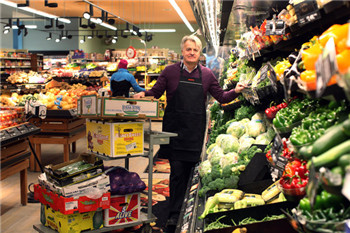(单词翻译:单击)

OTTAWA — Steamed, sauted or stir-fried, cauliflower is standard fare on many dinner tables. In Canada, it is a luxury.
渥太华——蒸、嫩煎或煸炒的花菜,在许多地方的餐桌上是一道家常菜。在加拿大,却是一种奢侈。
A head of cauliflower there now goes for around 8 Canadian dollars, a tripling in price, the strange foodie fallout from the low price of oil and other commodities.
如今一个花菜在那里可以卖到大约8加元(约合38元人民币),价格是原来的三倍,这是石油和其他大宗商品价格走低连累“吃货”的一个古怪案例。
The recipe for high-priced cauliflower starts with the currency.
天价花菜的出现,首先要从汇率说起。
As prices for commodities have dropped, the value of the Canadian dollar has fallen, a direct link to an economy that is dependent on oil and other resources. It makes imports, like fresh American vegetables during the dark Canadian winter, look especially costly.
随着大宗商品价格下跌,加元出现贬值,对于一个依赖石油和其他资源的经济体来说,这是一种直接的联动。这就导致进口商品的价格显得格外夸张,比如在天昏地暗的加拿大隆冬时节从美国进口的新鲜蔬菜。
Two years ago, one Canadian dollar was worth 93 American cents. On Wednesday, it stood at 69 American cents.
两年前,一加元相当于93美分。在本周三是69美分。
The drought in California, where Canadians get most of their vegetables in the off-season, just compounds the sticker shock. With less bounty in the fields, farmers’ prices, in American dollars, are higher than normal.
而加拿大的非时令蔬菜大多来自加州,那里的旱情也加剧了价格的暴涨。由于收成不佳,以美元计的农产品价格要高于正常水平。
As a result, fresh vegetables feel more like a splurge for Canadian consumers.
这样一来,新鲜蔬菜在加拿大消费者眼里就成了奢侈品。
Iceberg lettuce sells for 3 Canadian dollars, up from the typical 90 Canadian cents. One head of broccoli goes for $4, compared with $1.50 for two in the past. Last winter, a head of cauliflower was selling for 2.50 Canadian.
圆生菜售价从平常的90加分涨到了3加元。一个西兰花卖到4加元,在过去1.50加元可以买到两个。去年冬天,一个花菜的价格是2.50加元。
“We’ve gone through this cycle before with the dollar,” said Jim McKeen, owner of McKeen Metro Glebe, a grocery store in downtown Ottawa. “But there were issues on prices anyways because of supply in addition to this whole fiasco with the Canadian dollar. It’s a perfect storm.”
“这些汇率的事以前全都经历过,”渥太华市中心食品杂货店McKeen Metro Glebe老板吉姆·麦基恩(Jim McKeen)说。“但是供应不足决定了价格本来就会有问题,再加上加元惨成这样,就成了一场完美风暴。”
The Canadian dollar, in part, reflects the trouble in the country’s economy.
加元一定程度上反应了该国的经济困境。
For years, Canada rode the global commodities boom. The rapidly growing Chinese economy — and its seemingly insatiable appetite for commodities — helped increase the price of oil, potash, nickel and the other Canadian resources.
加拿大多年来得益于全球大宗商品的繁荣。快速增长的中国经济——及其看上去永无止境的大宗商品需求——推高了石油、钾盐、镍和其他加拿大资源的价格。
With China’s demand now faltering, commodity prices have reversed course. Oversupply of oil has similarly devastated its price. Both factors are taking their toll on the Canadian economy. The gross domestic product increased just 0.6 percent in the third quarter of 2015, after six months of negative growth.
随着中国的需求增长放缓,大宗商品价格急转直下。石油的供过于求也对价格造成了类似的冲击。这两个因素都在危害加拿大经济。在经过六个月的负增长后,其国内生产总值在2015年第三季度只增长了0.6%。
Since October, the decline in the Canadian dollar, already looking shaky against a surging American currency, has picked up speed.
自去年10月以来,加元加速贬值,与强劲的美元相比,加元显得摇摇欲坠。
In many ways, a weaker currency is helpful to the economy. The United States is overwhelmingly the largest market for Canadian exports, which are now less expensive across the border because of the currency’s fall.
从很多方面来看,走软的货币对经济有利。美国是加拿大最大的出口市场,远超其他国家。由于货币贬值,加拿大出口商品的价格有所降低。
And commodity exports are almost all priced in American dollars. So foreign exchange gains have helped cushion some of the blow to Canadian oil producers and mining companies, which largely sell their resources elsewhere.
出口大宗商品的价格几乎都是以美元定价。因此,外汇收益在一定程度上缓和了加拿大石油生产商和矿业公司遭受的冲击,这些企业开采的资源主要销往其他地区。
“From a household point of view, what Canadians see is that their dollar isn’t going as far,” said Craig Alexander, vice president of economic research at the C.D. Howe Institute, an economic analysis and policy group “But it’s good for Canadians, it’s good for jobs. The primary driver for economic growth going forward has to come from nonresource export sectors.”
“普遍看法是,加拿大人认为加元不会一路跌下去,”经济分析及政策研究机构C·D·豪研究所(C.D. Howe Institute)负责经济分析的副所长克雷格·亚历山大(Craig Alexander)说。“但这对加拿大人有利,对就业有利。经济继续增长的主要驱动力来自非资源型出口领域。”
Canada’s tourism industry and other service sectors, which had been suffering, are already experiencing gains from the currency drop. Luke Azevedo, the film commissioner for Calgary Economic Development, said there had been a notable rise in production in Alberta, where large portions of the movie “The Revenant” and the television series “Fargo” were filmed last year.
步履艰难的加拿大旅游业及其他服务行业,已经从货币贬值的形势中受益。卡尔加里经济发展局(Calgary Economic Development)电影专员卢克·阿塞韦多(Luke Azevedo)表示,艾伯塔省的制片活动显著增多。去年,电影《荒野猎人》(The Revenant)和电视剧《冰血暴》(Fargo)的很多场景都是在卡尔加里拍摄的。
“It’s across the country and the dollar plays a fairly significant role,” Mr. Azevedo said.
阿塞韦多说,“全国都是这样,加元汇率发挥了重要作用。”
Speaking at the World Economic Forum in Davos, Switzerland, on Wednesday, Prime Minister Justin Trudeau emphasized Canada’s strengths in technology and education rather than its ailing natural resource sector.
周三,加拿大总理贾斯廷·特鲁多(Justin Trudeau)在瑞士达沃斯举行的世界经济论坛(World Economic Forum)发表讲话时,强调了加拿大在技术和教育方面的优势,并未多谈状况欠佳的自然资源行业。
“Our natural resources are important and always will be,” Mr. Trudeau said. “But Canadians know that growth and prosperity is not only based on what’s under our feet but particularly on what we have between our ears.”
“我们的自然资源非常重要,将来也是如此,”特鲁多说。“但加拿大人知道,发展和繁荣不仅仅是基于我们脚底下的资源,还尤其要依靠我们的头脑。”
Consumer costs are creeping up in a number of areas.
在一些领域,消费者的购物成本在逐渐提高。
The turnover in the grocery aisle, compared with, say, a clothing store, is faster, meaning changes in currency are more quickly reflected. And profit margins are thin, so grocery stores are less willing to absorb the losses.
例如,与服装店相比,食杂店的价格上涨得更快一些,这意味着杂货店更快速地体现了汇率波动。由于利润空间非常微薄,食杂店更不愿承受这种损失。
The current collapse of the country’s dollar could have a more significant impact in supermarkets than it did in the early 2000s, according to Sylvain Charlebois, a professor at the University of Guelph in Ontario and one of the authors of an annual study of Canadian food prices.
安大略省圭尔夫大学(University of Guelph)教授西尔万·沙勒布瓦(Sylvain Charlebois)表示,与2000年代初期的情况相比,目前加元汇率暴跌的形势可能会给超市带来更为显著的影响。沙勒布瓦跟其他人合著了一份关于加拿大食品价格的年度研究报告。
Professor Charlebois estimated that about 140 Canadian food processing plants have closed in recent years. Many were owned by multinationals that have replaced Canadian production with imports from their larger American plants. Kellogg’s ended a century of production in London, Ontario, just over a year ago.
据沙勒布瓦教授估计,近些年来约有140家加拿大食品加工厂关门。很多加工厂归跨国公司所有,这些公司用规模更大的美国加工厂生产的进口产品,代替加拿大本地生产的产品。一年多以前,家乐氏(Kellogg)停止了该公司在安大略省伦敦市已经持续百年的生产活动。
The result, Professor Charlebois said, is that price increases will be seen throughout grocery stores and not just in their fresh produce aisles. Already, he said, some breakfast cereals have hit 10 Canadian dollars.
沙勒布瓦教授表示,结果就是,不仅新鲜农产品的价格会上涨,食杂店商品的价格也会抬高。他表示,一些谷类早餐的价格已经达到10加元。
Fishermen in Prince Edward Island now send most of their oyster harvest to the United States to capitalize on the currency difference. That’s leading to shortages at Canadian fishmongers, forcing some restaurant owners to reimport from the United States.
爱德华王子岛的渔民现在将收获的大多数牡蛎都运往了美国,以便利用汇率差价获利。这导致加拿大鱼贩缺货,迫使一些餐厅老板从美国再进口牡蛎。
“It’s mind-boggling that I have to buy Malpeque oysters from my American importer in Boston,” said David McMillan, the co-owner of Joe Beef and two other restaurants in Montreal, adding that the cost of the oyster from Prince Edward Island had risen to 120 Canadian dollars a box from about 90 Canadian dollars. “That’s a lot of money for not a special oyster.”
“我得从美国波士顿的进口商那里购买莫尔佩克产的牡蛎,这真是令人难以置信,”戴维·麦克米伦(David McMillan)说。麦克米伦在蒙特利尔与别人合开了Joe Beef及其他两家餐厅。他还表示,爱德华王子岛出产的牡蛎价格从一箱90加元上涨到了120加元。“对于并不特别的牡蛎来说,这个价格太高了。”


